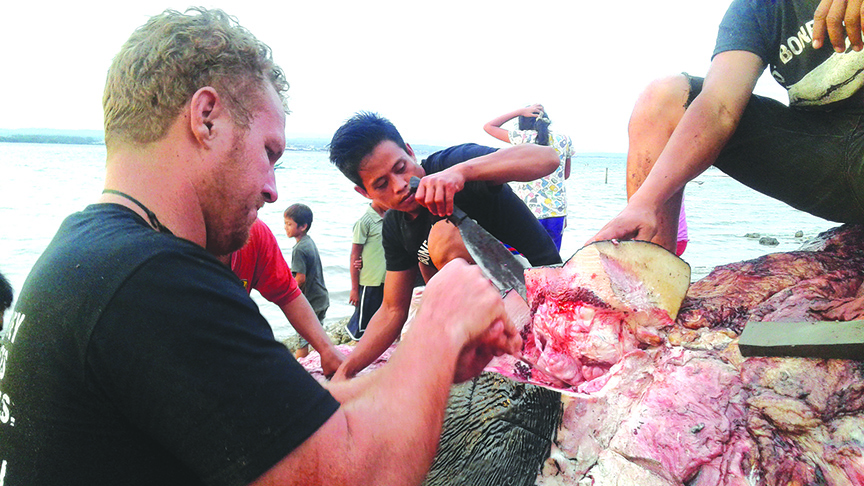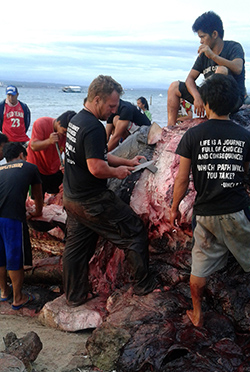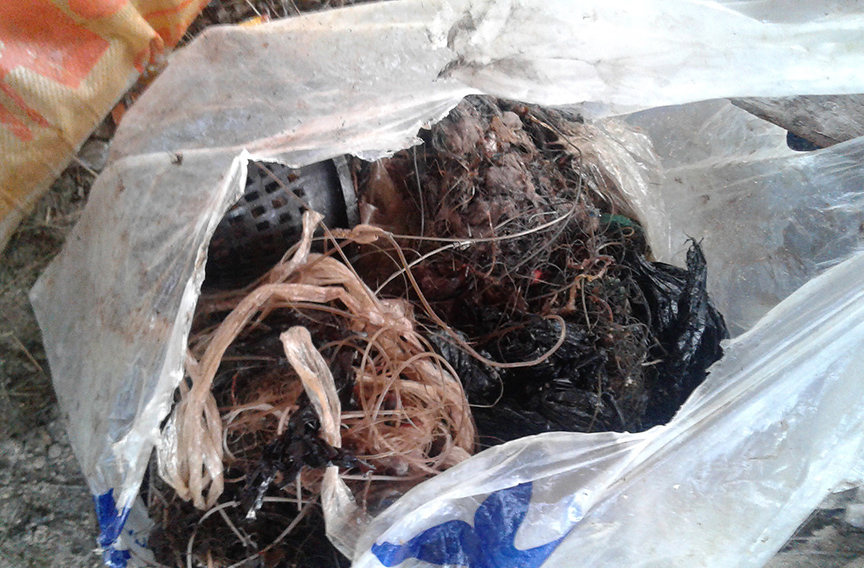
For some, the death of the seven-year old and 38-feet long juvenile male sperm whale in Babak District, Island Garden City of Samal (IGACOS) in Davao del Norte was just one of the ordinary happenings within the Davao Gulf area.
Local residents said this was not the first time that the body of a sea-dwelling beast of burden was swept ashore – such occurrence they also witnessed before.
“Nakakita pud ko ani niadto (I witnessed this occurrence before),” said Ricardo, a 53 year old tricycle driver from Babak.
But Ricardo could not tell the cause of the previous deaths of whales and other sea creatures he witnessed – “Basta ingon nila naigo daw sa sabad sa dakung barko (I was told it was hit by a propeller of a huge cargo ship).”
Last Saturday, December 17, Ricardo and more than a hundred residents in Babak saw how a backhoe pulled ashore another dead sperm whale.
Some fishermen in the area told EDGE Davao that they already saw the sperm whale Friday afternoon alive, floating but very weak.
By Saturday morning, they added, it was already dead.
Again, they suspected that the young sperm whale was hit by a propeller of a cargo ship.
The necropsy report

Darrell Blatchley, of the famous Bone Collector Museum in Davao City, was contacted by the Bureau of Fisheries and Aquatic Resources (BFAR) on Saturday to perform a necropsy on the dead sperm whale.
Blatchley and his team were also contracted by the city government of IGACOS to clear, clean and preserve the bones of the dead sperm whale.
It is the aim of the city government of IGACOS to preserve the skeleton of the dead sperm whale and display for public viewing in the city.
Blachley told EDGE Davao on Saturday that it would take them nearly two years to complete their works, including the process of preservation.
“After two years, we will bring back the complete skeleton of this sperm whale here in Samal for public display and viewing,” he said.
But what struck Blatchley and his team after the necropsy was the discovery of lots of garbage – mainly composed of plastics in the stomach of the dead sperm whale.
“We recovered lots of plastic bags, a mug-size plastic basket, parts of fishing net and an almost foot long 2×2 wood with protruding nail inside the stomach of the dead sperm whale,” he reported.
Blatchley also disagreed with the rumors that the sperm whale died due to a wound when hit by a propeller of a cargo ship.
He suspected that the young marine mammal was poisoned due to too much intake of plastics and other forms of non-biodegradable garbage from its habitat.
They also discovered string-like white parasites from the stomach of the dead sperm whale.
Blatchley said the wounds found in the body of the dead sperm whale were not life threatening as these were only bites from other marine creatures such as sharks and giant squids.
“Davao Gulf is still rich in marine resources. We also found remains of shark bones and giant squids from its stomach. These are the foods of sperm whales,” he added.
Alarming
Blatchley expressed alarm over the cases of death of marine mammals due to pollution and human intervention.

Aside from the death of the sperm whale in IGACOS, he said that a dwarf sperm whale was also killed by strikes of propeller of a ship last December 15 in the town of Sta. Maria in Davao Occidental.
The 2.8-meter female dwarf whale was also pregnant, he added.
For the last 7 years, Blatchley said they were able to respond to 56 cases of death of marine mammals in Mindanao, most, or 54 of which, were in Davao region.
Of the 54 cases of deaths in Davao region, only four of the marine mammals died of natural death – the other 50 were due to human intervention and pollution, he added.
He put across his concern over the seemingly improper disposals of garbage especially of plastics that are considered non-biodegradable.
The presence of plastics and other forms of garbage in the habitat of the marine mammals in the region is evident with the findings they made in the necropsy of a juvenile sperm whale.
He pointed out that awareness and campaigns to conserve the environment must be done to save the marine resources in the Davao Gulf and other areas in Mindanao.
“We do clean up drives once a year but people continue to improperly dispose garbage daily – 365 days. Worst things will happen to our environment and the seas if this will continue,” Blatchley said.






